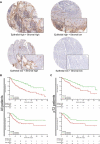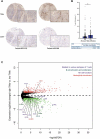Tumor stroma-infiltrating mast cells predict prognosis and adjuvant chemotherapeutic benefits in patients with muscle invasive bladder cancer
- PMID: 30393586
- PMCID: PMC6209422
- DOI: 10.1080/2162402X.2018.1474317
Tumor stroma-infiltrating mast cells predict prognosis and adjuvant chemotherapeutic benefits in patients with muscle invasive bladder cancer
Abstract
Which subgroups patients with muscle-invasive bladder cancer (MIBC) could benefit most from adjuvant chemotherapy (ACT) is blurred. Here we tried to stratify MIBC patients with tumor infiltrating mast cells (TIMs), explore the prognostic and predictive value of TIMs, and provide possible cellular explanations. We selected 259 MIBC patients who underwent radical cystectomy from two independent clinical centers between 2002 and 2014. TIMs were evaluated and prognostic and predictive value was assessed. The CIBERSORT method, Gene Set Enrichment Analysis (GSEA) and differential gene expression analyses were performed to explore the possible cellular mechanisms. TIMs infiltration was distinct between stromal and epithelial area of MIBC specimens. Patients with higher stromal TIMs had a significant worse overall survival and recurrence free survival (HR = 2.228, 95%CI: 1.467-3.550; P = 0.001 and HR = 1.984, 95%CI: 1.105-3.374; P = 0.016). More importantly, pT2 patients with low stromal TIMs tended to have a lower risk of death and recurrence after ACT (HR = 0.233, 95%CI: 0.020-0.814; P = 0.033 and HR = 0.180, 95%CI: 0.022-0.722; P = 0.031). A negative correlativity between TIMs and CD8 + T cells was identified on TCGA-BLCA cohort. Immunohistochemistry results validated that high stromal TIMs were negatively correlated with CD8 + T cells (Spearman's rho = -0.215, P < 0.001). Differential gene expression suggested that low TIMs might represent a state of immune activation in MIBC. To conclude, high stromal TIMs infiltration was an independent unfavorable prognosticator for MIBC patients. Patients with low stromal TIMs might benefit the most from ACT, especially in pT2 stage.
Keywords: adjuvant chemotherapy; bladder cancer; mast cells; overall survival; prognosis; recurrence-free survival.
Figures




References
-
- Advanced Bladder Cancer Meta-analysis C Adjuvant chemotherapy in invasive bladder cancer: a systematic review and meta-analysis of individual patient data Advanced Bladder Cancer (ABC) Meta-analysis Collaboration. Eur Urol. 2005;48:189–199; discussion 99–201. doi:10.1016/j.eururo.2005.04.005. - DOI - PubMed
-
- Leow JJ, Martin-Doyle W, Rajagopal PS, Patel CG, Anderson EM, Rothman AT, Cote RJ, Urun Y, Chang SL, Choueiri TK, et al. Adjuvant chemotherapy for invasive bladder cancer: a 2013 updated systematic review and meta-analysis of randomized trials. Eur Urol. 2014;66:42–54. doi:10.1016/j.eururo.2013.08.033. - DOI - PubMed
Publication types
LinkOut - more resources
Full Text Sources
Research Materials
